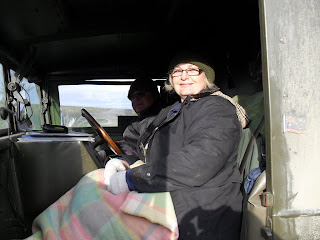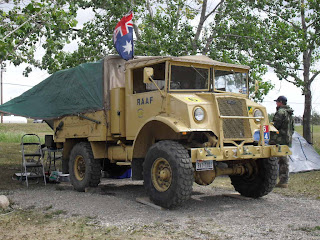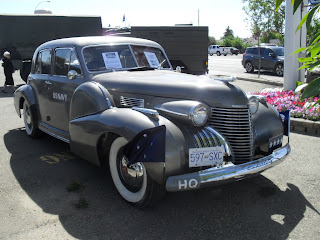Another very cold start to the day so windows were on the
van again. We crossed the wide and silty
Donjek River. The current bridge is 3
miles downriver from the original, which crossed at a narrower location. The new bridge was built in 2009 and named from
the Indian word for a peavine that grows in the area.
Destruction Bay was another point passed today. During the early years, driving the highway
was difficult and often dangerous, causing wear and tear on both men and machines. Destruction Bay was one of the relay stations
which were spaced at 100 mile intervals to give drivers a break and to service
vehicles.
The drive along the Kluane Lake was one of the most
spectacular sights of the trip so far.
Beautiful aqua coloured water at the base of a mountain and it was quite
a long drive. Unfortunately we had chosen
this day to put our windows on so lost many photo opportunities. It is certainly a place that we would
recommend to anyone travelling in the continent of North America. Our lunch stop was at Soldier’s Summit where
on November 20, 1942 a ribbon cutting ceremony in -35 degrees was held to
officially open the Alaska Canada Military Highway. At this point you can see where the glacial
silt meets the aqua coloured water of the lake.
It was a day of beautiful scenery driving through the Kluane
National Park. A spectacular mountain
range in the distance with some snow capped mountains and driving over flowing
rivers and creeks. At the lunch stop we
removed the windows but forgot to wash the front windows which had been splattered
with mud earlier in the morning when we were going through roadworks. All photos had to be taken through the
passenger side of the window. This
frightens the living daylights out of oncoming drivers as they think it is the “driver”
hanging out of the window taking photos - the look on their faces is
priceless. As they get a bit closer they
realise that the driver is on the other side of the vehicle.
We arrived at Haines Junction mid afternoon and set up camp
amongst the birch trees. That night we
had a friendly little squirrel hanging around our campsite - he was obviously
used to human contact.
Haines Junction is known for its amazing scenery. The town was established in 1942 during the
construction of the Alaska Highway and the village lies in the Shakwak Valley
in south western Yukon. It is the
junction of the Alaska Highway with the Haines Road, a 160 mile highway built
to access the coast for supplying crews by ship.
In 1903 gold was discovered east of Kluane Lake. More than 2,000 gold seekers poured into the
area with high hopes but little gold was found and most of the miners moved on
within a year. This short lived gold
rush precipated the building of a wagon road between Whitehorse and Silver
City. It was along this wagon road that
the Alaska Highway would eventually be built in 1942.
Kluane National Park is one of the world’s largest
internationally protected areas and home to grizzly bears, moose, wolves, Dall
sheep and mountain goats. It is also
where Canada’s highest mountain peak – Mount Logan can be found.


































